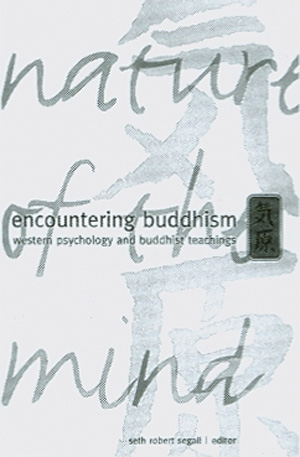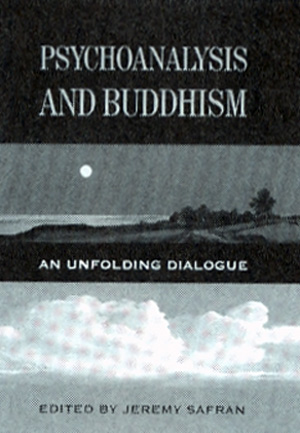 Encountering Buddhism: Western Psychology and Buddhist Teachings
Encountering Buddhism: Western Psychology and Buddhist Teachings
Seth Robert Segall, Ed.
Albany: State University of New York Press, 2003
214 pp.; $57.50 (cloth), $18.95 (paper)
Psychoanalysis and Buddhism: An Unfolding Dialogue
Jeremy D. Safran, Ed.
Boston: Wisdom Publications, 2003
464 pp.; $19.95 (paper)
A friend of mine, a math whiz financier obsessed with superlatives, once halted a round of perfectly genial dinner-party talk with a surprisingly divisive query: Which is smarter, he wondered, the ant or the bee?
I think of his question every time another volume appears amid the growing shelfload of titles attempting to straddle the gap between Eastern and Western views of mind. Some of the earlier works emphasize divergence and contradiction; others focus on overlap and synergy. Some are daring solo efforts; others reflect a range of traditions and expertise. Some whisper about breathtaking possibilities; others fill the air with the sound of one hand clapping its owner on the back. Taken as a group, however, they share several traits. For one thing,meditation is often used as a synonym for Buddhism, and Buddhism as a blanket term for a diverse array of practices and beliefs. For another, the authors, in addressing the goals and methods of psychotherapy, tend to speak to the analytic priesthood, leaving the curious but unanalyzed meditator lost in a linguistic funhouse, wondering how to tell her ideal ego from her ego ideal. What’s more, there’s an insidiously reductionist tilt to much of the writing. The innocent reader is apt to come away believing that psychotherapy is merely a damp rag for the mundane messes that even lengthy and intensive Buddhist training can leave behind—a psychic Swiffer, as it were, for all those lascivious lamas and their codependent acolytes. Buddhism’s potential contribution to psychotherapy, meanwhile, is often pared down to the utility of mindfulness techniques for the doctor or patient trying to “stay present” in the consulting room.
Encountering Buddhism and Psychoanalysis and Buddhism, two recent additions to the canon, illustrate the genre’s weaknesses and strengths. Both offer the work of Buddhist practitioners and prominent therapists from a variety of schools—Theravada, Tibetan, and Zen; Jungian, Freudian, and Lacanian—and both accept as a given that each side has something to learn from the other. And while both books sometimes sink into the swamps of jargon and abstraction, each manages in places to rival the best of the comparative commentaries published so far.
Of the two, Encountering Buddhism is the more straightforward and unsurprising. Part of the State University of New York series on Transpersonal and Humanistic Psychology, it showcases the thinking of eight contributors steeped in Buddhist practice, all with clinical or scholarly credentials in the field of psychology. Robert Rosenbaum, for example, is a staff psychologist at Kaiser-Permanente who has practiced Zen for more than two decades. In his thoughtful and evocative “Reflections on Mirroring,” he spins a rich connective thread between Dogen Zenji, the thirteenth-century founder of the Soto Zen lineage, and Heinz Kohut, the twentieth-century father of self psychology, which stresses the importance of empathy in the therapeutic relationship.
But it’s the contribution of Pali scholar Andrew Olendzki—who heads the Barre Center for Buddhist Studies and writes here about Buddhism as a psychological system—that stands out as a model of compelling clarity. “The question,” Olendzki argues, “is not, What is the nature of the world out there? but rather, How does the mind go about constructing stability, identity, satisfaction, and beauty from an environment that itself lacks these qualities? And, What are the consequences of these distortions for the subject who constructs them?”
 As for the rest, there’s something rather scattershot about editor Seth Robert Segall’s selection and order. The remaining pieces in Encountering Buddhism fail to add up to a true encounter, or to say anything truly new. That explains, in part, why Psychoanalysis and Buddhism feels so much more rewarding—and why its own shortcomings are all the more poignant. As the subtitle (“An Unfolding Dialogue”) suggests, editor Jeremy D. Safran has arranged a conversation of sorts between Buddhism and psychoanalysis. Nine writers versed in both disciplines first have their say on topics ranging from surrender and ego-dissolution to therapeutic transference and the well-lived life. Their essays are followed by comments from psychoanalytic theorists whose knowledge of Buddhism is considerably more cursory. The original writers then wind up the discussions with their responses to the critiques.
As for the rest, there’s something rather scattershot about editor Seth Robert Segall’s selection and order. The remaining pieces in Encountering Buddhism fail to add up to a true encounter, or to say anything truly new. That explains, in part, why Psychoanalysis and Buddhism feels so much more rewarding—and why its own shortcomings are all the more poignant. As the subtitle (“An Unfolding Dialogue”) suggests, editor Jeremy D. Safran has arranged a conversation of sorts between Buddhism and psychoanalysis. Nine writers versed in both disciplines first have their say on topics ranging from surrender and ego-dissolution to therapeutic transference and the well-lived life. Their essays are followed by comments from psychoanalytic theorists whose knowledge of Buddhism is considerably more cursory. The original writers then wind up the discussions with their responses to the critiques.
Besides offering, as Safran notes, “a taste of some of the exciting and forward-looking developments” brewing within contemporary psychoanalysis, this approach affords the primary authors a chance to expand on certain dense or murky points and to hone their thinking overall. (Joseph Bobrow’s response to James Grotstein, for instance, is even more lucid and lively than Bobrow’s original essay, “Moments of Truth—Truths of Moment,” on attention and intimacy in the analytic process.) The back-and-forth also provides the reader with the gratifying spectacle of seeing analyst and Zen priest Raul Moncayo slyly called to account for his tortuous Lacanian prose. (“Since no one object can fill the gap of being,” Moncayo writes, ostensibly by way of clarification, “working through the loss at the core of being, instead of appealing to phantasy to prevent the loss, transforms the ‘nonbeing of being’ into the ‘being of nonbeing’ or dual nothingness into non-dual emptiness. Here being folds upon itself and into the opening of the hole or lack within being or the ‘nonbeing of being.’”)
Thankfully, even Moncayo is amply redeemed elsewhere, especially in the contributions by Mark Finn, Barry Magid, and Polly Young-Eisendrath. Indeed, Young-Eisendrath, in her discussion of transference and transformation, is the only writer in either book to strictly define her terminology and carefully delineate the boundaries of her argument.
The true centerpiece of Psychoanalysis and Buddhism, however, is the essay by Jack Engler, a reconsideration of the now-famous dictum he uttered some twenty years ago: “You have to be somebody before you can be nobody.” With impressive subtlety and dazzling insight, Engler artfully teases apart the two notions of self that his statement assumes—the self that therapy endeavors to strengthen and the self that Buddhism, at its radical best, aims to expose as essentially empty. “The need to reclaim and develop a healthy sense of self and self-esteem, a capacity for intimacy, and a creative way to live in the world with full commitment, cannot and should not be separated from Western spiritual practice,” he writes.
As Engler freely admits, his argument is still less than completely satisfying on the matter ofwhy a notion of enduring self is constructed in the first place. But in light of what he’s achieved here, it’s an excusable failing. Like the question about the ant and the bee, it serves as the perfect invitation for further dialogue.
Thank you for subscribing to Tricycle! As a nonprofit, we depend on readers like you to keep Buddhist teachings and practices widely available.